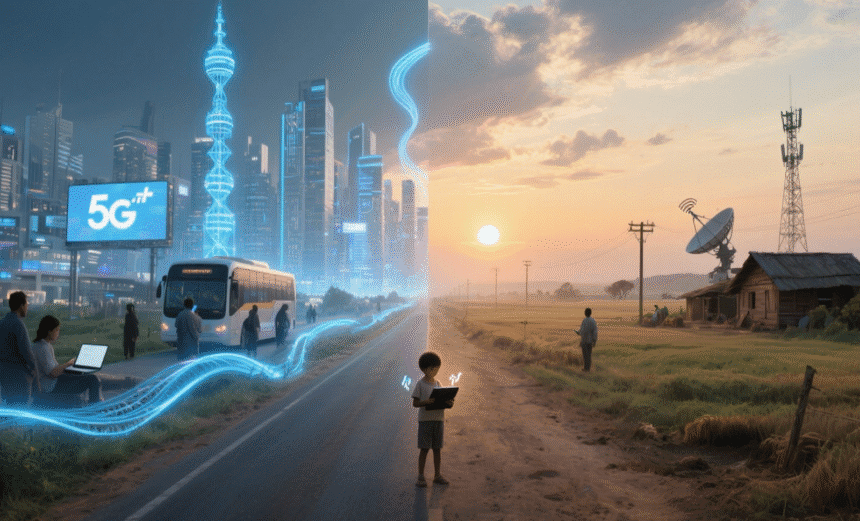In the age of rapid technological advancement, the world stands divided not just by geography or income but also by access to digital resources. The term “digital divide” has become a defining phrase of the 21st century, describing the gap between those who have access to information and communication technologies and those who do not. This divide, particularly between rural and urban areas, continues to grow despite global efforts to promote digital inclusion.
The roots of the digital divide can be traced back to the late 1990s, when the internet began transforming urban economies and lifestyles. Cities, with their concentrated populations and higher incomes, quickly adopted digital technologies, while rural areas were left behind. In 2025, even as the world celebrates unprecedented connectivity, the gap between rural and urban internet users remains wide. According to global data, internet penetration has reached over 67%, yet millions in rural communities still live without reliable access to broadband or even mobile internet.
The reasons behind this divide are complex. Infrastructure inequality remains one of the primary causes. Laying fiber-optic cables or building towers in remote, sparsely populated regions is often considered economically unviable for telecom companies. As a result, while urban centers enjoy 4G and 5G coverage, many rural villages still rely on patchy 2G networks. Another major barrier is affordability. Digital devices and data services remain costly for low-income households. In India, for example, urban users spend an average of ₹350 per month on mobile data, but for rural families, even half that amount can be unaffordable.
Beyond cost and infrastructure, digital literacy is another major challenge. Millions of people in rural areas lack the skills to use smartphones, computers, or online services effectively. A UNESCO report estimates that 37% of rural adults globally lack basic digital literacy, which prevents them from accessing e-learning, telemedicine, or e-commerce platforms. Social and gender barriers further deepen the gap. In parts of Africa and South Asia, women in rural communities are 30% to 50% less likely to use the internet compared to men, restricted by cultural norms, limited education, and social inequality.
The impact of this divide is far-reaching. During the COVID-19 pandemic, the world witnessed how digital access could determine opportunity. While urban students shifted to online learning, millions of rural children were cut off from education entirely. A UNICEF report revealed that two-thirds of school-aged children globally lacked internet access at home, with the vast majority living in rural or low-income areas. Economically, the gap limits rural participation in the digital economy. A World Bank study (2024) found that a 10% increase in broadband penetration can raise a country’s GDP by up to 1.5%, highlighting how connectivity drives growth. Rural regions without access to digital tools miss out on e-commerce, online banking, and remote work opportunities that have become essential in the modern world.
The digital divide also has consequences for healthcare. Telemedicine, which has revolutionized access to doctors and diagnostics in cities, remains largely inaccessible in rural areas. Weak connectivity and low digital awareness prevent rural populations from using health apps or online consultations. The result is an uneven playing field, one where technology widens, rather than narrows, social inequality.
Globally, the statistics paint a stark picture. In India, urban internet penetration stands at 83%, while rural penetration lags at 39%, according to the Telecom Regulatory Authority of India (TRAI). In the United States, about 17% of rural residents still lack access to high-speed broadband compared to just 1% in urban areas, as reported by the Federal Communications Commission (FCC). In Sub-Saharan Africa, over 60% of the rural population remains offline due to high costs and limited infrastructure. In contrast, Europe offers examples of progress; countries like Finland and Estonia are closing the gap through strong national broadband policies and government-funded connectivity programs.
Efforts to bridge the divide are underway worldwide. India’s ambitious BharatNet Project aims to connect 250,000 village councils with fiber-optic broadband, while private initiatives like Starlink and OneWeb are deploying satellite internet to reach remote and mountainous areas globally. The United Nations Development Programme (UNDP) and the International Telecommunication Union (ITU) are running campaigns to enhance digital literacy, especially for women and youth in rural regions.
Experts agree that closing the digital divide will be one of the defining challenges of this century. As artificial intelligence, e-governance, and digital payments become central to everyday life, access to the internet is no longer a luxury; it is a basic necessity. Bridging this gap will determine whether the digital revolution becomes an equalizing force or a new form of exclusion. The goal is clear: to ensure that no community, however remote, is left behind in the digital age.

















